8 Strategic Ways to Optimize Zero-Click Searches
The growing trend of zero-click searches transforms how users find information and how businesses must adapt their digital strategies. Zero-click searches provide instant answers directly on search engine results pages, eliminating the need for users to visit websites. Recent data shows that 60% of Google searches in America and Europe ended without a click in 2024. This guide explores what zero-click searches are, why they matter, and how you can optimize your content to maintain visibility despite this trend.
What are Zero-Click Searches?
Zero-click searches happen when Google displays information that answers a user’s question directly on the search results page, eliminating the need to click through to a website. These instant answers appear in various formats, including featured snippets, knowledge panels, and direct answer boxes.
When you search for basic information like “How old is Tom Cruise” or “weather in Axminster,” Google shows the answer immediately at the top of the results. This convenience helps users but creates challenges for website owners who previously received traffic from such queries.
The trend continues to grow. According to Semrush’s zero-click study, 25.6% of desktop searches and 17.3% of mobile searches result in zero clicks.
Types of Zero-Click Search Results
Zero-click searches appear in several formats across Google’s results pages:
Featured Snippets
These text blocks appear at the top of search results, providing direct answers in two to three sentences. Featured snippets typically include a summary of the answer, extracted from a webpage, along with the page’s title and URL. They may include:
1. Paragraph Snippet
A paragraph snippet is a type of featured snippet that appears at the top of Google’s search results, often in response to question-based queries like “What is…?” or “How does…?”.It usually displays a brief paragraph (40–60 words) taken directly from a webpage that clearly and concisely answers the user’s question without needing them to click.
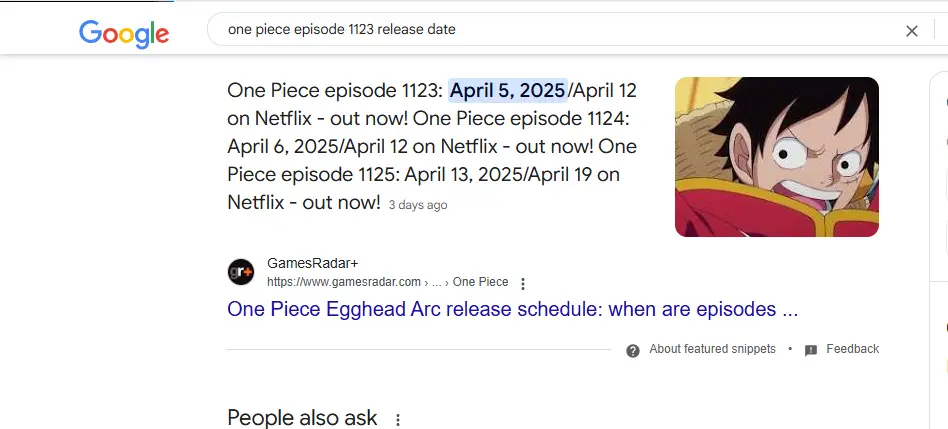
2. Lists Snippet
A list snippet is another form of featured snippet where Google displays content as a bulleted or numbered list directly in the search results. These are triggered by queries that imply steps, rankings, or itemized answers.
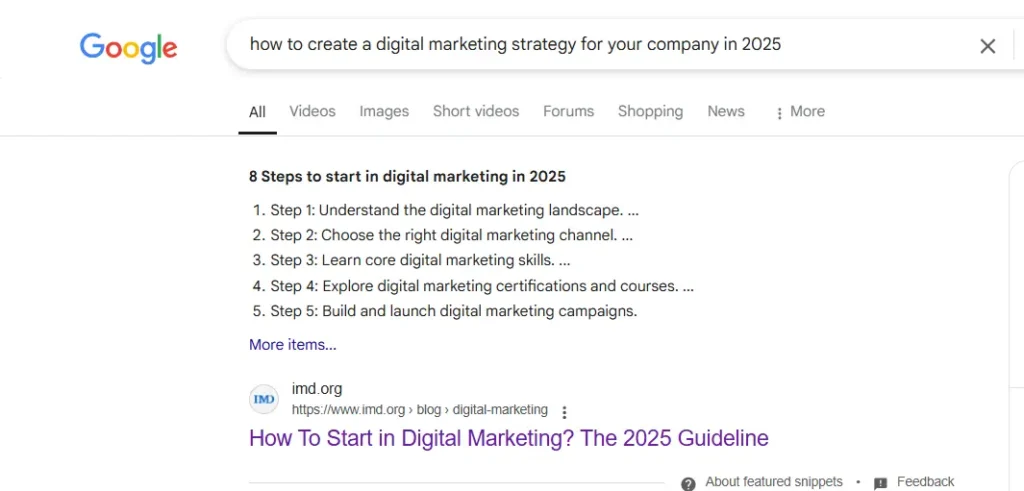
3. Table Snippet
A table snippet is a featured snippet where Google pulls structured data from a webpage and presents it as a mini-table in the search results. This format is perfect for showing comparisons, pricing, schedules, or stats.
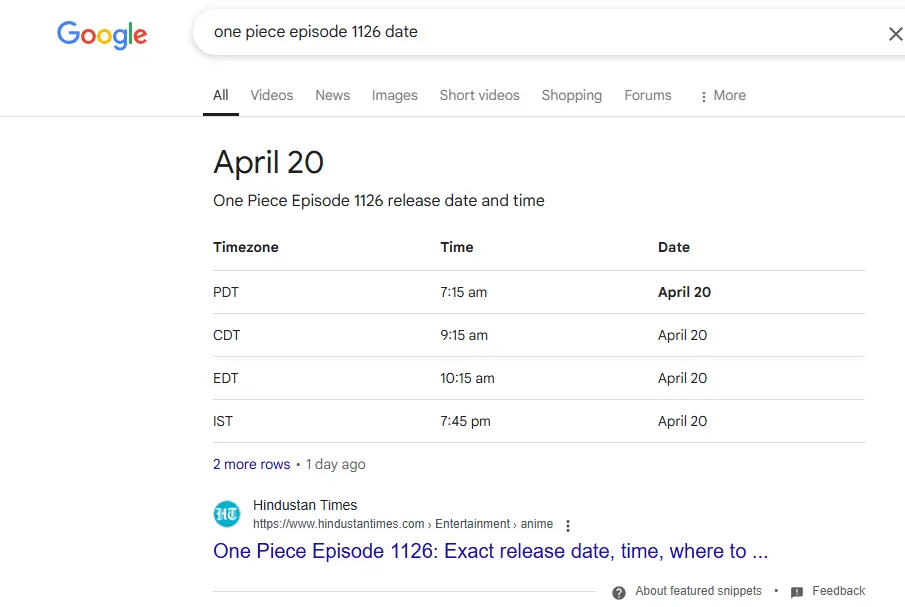
4. Video Snippet
A video snippet is a featured snippet where Google displays a video preview often pulled from YouTube that directly answers the user’s query. These snippets usually include timestamps and captions, letting users jump to the exact part of the video that solves their problem.
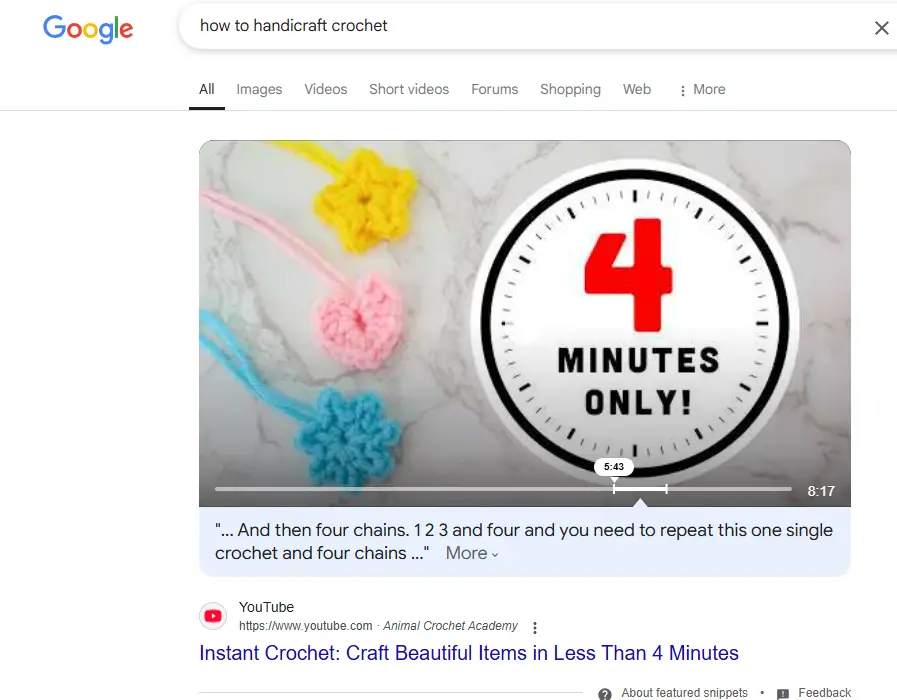
5. Rich Snippet
A rich snippet is a regular search result enhanced with extra information pulled from structured data (like schema markup). Unlike featured snippets, rich snippets don’t appear above all results, but they stand out visually and attract more clicks.
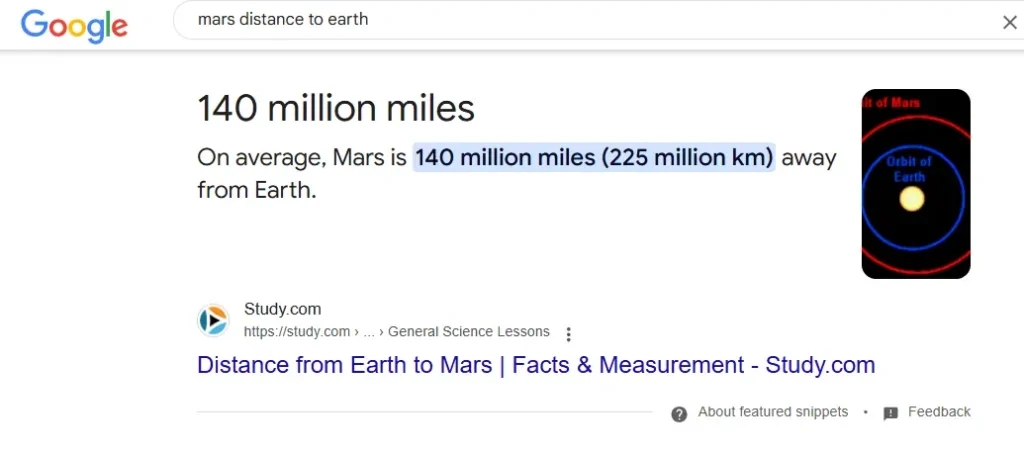
Knowledge Panels
Knowledge panels display comprehensive information about entities like people, places, organizations, or concepts in a box on the right side of search results. These panels compile key facts, images, and related information.
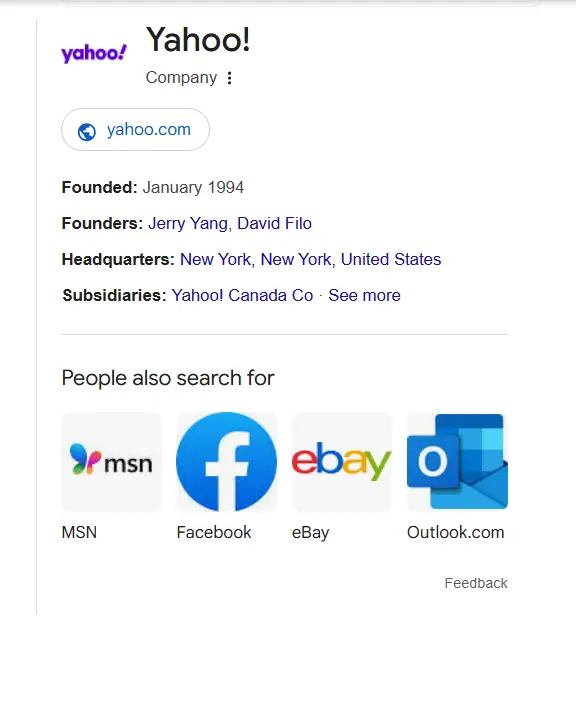
People Also Ask
These expandable question boxes show related queries that users commonly ask about your search topic. When clicked, they reveal answers without requiring users to leave the results page.
AI Overview
For straightforward factual questions, Google often displays direct answers at the top of results without attribution to any specific website.
Local Packs
Local business information appears in map-based results with business hours, ratings, and contact details for location-based searches.

Instant Answers
Instant Answers are direct responses that appear at the top of Google’s search results, giving users quick information without needing to click through to a website. These typically show up for straightforward queries such as facts, definitions, calculations, conversions, time, or weather updates. For example, if someone searches “10 USD to EUR” or “CEO of Google,” Google provides the answer instantly on the results page.
Why Zero-Click Searches Matter
Despite potentially reducing website traffic, zero-click searches offer several benefits worth considering.When integrated into a broader digital marketing strategy, they can drive brand visibility, build trust, and spark direct searches that boost engagement long-term.
Increased Brand Visibility
Appearing in zero-click results places your content prominently on search results pages, increasing brand exposure even without clicks. This visibility introduces your brand to new audiences who might search for your name later.
Trust Building
When Google selects your content for featured snippets or knowledge panels, it signals to users that your information is authoritative and trustworthy. This perception boosts your brand reputation.
Strategies To Optimize For Zero-Click Marketing
Implementing these eight strategies will improve your chances of capturing valuable zero-click searches:
1. Target Question-Based Keywords
To align with user search intent, focus on keywords framed as questions. Tools like Google’s “People Also Ask,” Answer The Public, and BuzzSumo’s Question Analyzer can help identify what users are asking. Create content that delivers direct, clear answers using plain language. Since users often scan search results quickly, typically within 15 seconds, getting straight to the point increases engagement.
2. Structure Content For Featured Snippets
To increase your chances of being selected for featured snippets, structure your content intentionally. Begin with a clear answer in the opening paragraph. Use descriptive headings (H2s or H3s) that align with search phrases, and break down processes using numbered or bulleted lists. When applicable, use tables to present comparison data. Keep each paragraph under 50 words to enhance readability and snippet potential.
3. Develop Comprehensive FAQ Sections
Building an FAQ section allows you to address multiple user queries on a single page. Focus on common questions relevant to your industry and answer them in a direct, concise manner. Group similar questions to improve user experience and keep the content organized. Regular updates help maintain relevance. Applying FAQ schema also increases visibility in search.
4. Implement Schema Markup
Schema markup helps search engines understand your content better. Use the FAQ schema for question-based content and the How-to schema for step-by-step instructions. For businesses, the Local Business schema improves location visibility, while the Review and Article schema boost credibility and clarity for news or blog content. Structured data enhances your chances of ranking in rich results or knowledge panels.
5. Optimize For Voice Search
Voice search continues to drive zero-click interactions. To optimize, use a conversational tone and focus on natural-sounding, long-tail keywords. Answer questions in a direct, easy-to-understand format. Keep responses short, ideally under 30 words, to match voice assistant responses. Voice-optimized content improves both visibility and usability.
6. Create Definitive Content For Knowledge Panels
If you represent a business, brand, or individual with a notable presence, aim to appear in knowledge panels. Keep your Google Business Profile accurate and up to date. Having a verified Wikipedia page or being cited by authoritative sites also strengthens credibility. Ensure consistency in business name, contact details, and descriptions across all platforms. Link to reliable sources that validate your information.
7. Leverage Strategic LSI Keywords
Latent Semantic Indexing (LSI) keywords help search engines understand the context of your content better. Include relevant synonyms and variations naturally throughout your text. Use Google’s suggested searches to find LSI keyword ideas and avoid keyword stuffing. Vary anchor text and integrate LSI terms into headers, image alt text, and meta descriptions. Prioritize readability while maintaining keyword relevance.
8. Follow EEAT Guidelines
Crafting an article that highlights your expertise, authority, and trustworthiness aligns with Google’s E-A-T guidelines, boosting your chances of securing a featured snippet.
AI Overviews tend to favor well-established digital brands and prominent authors, particularly for blog content. However, for web pages that lack author bylines, Google appears to evaluate EEAT criteria differently, emphasizing the quality and relevance of the content over individual authority.
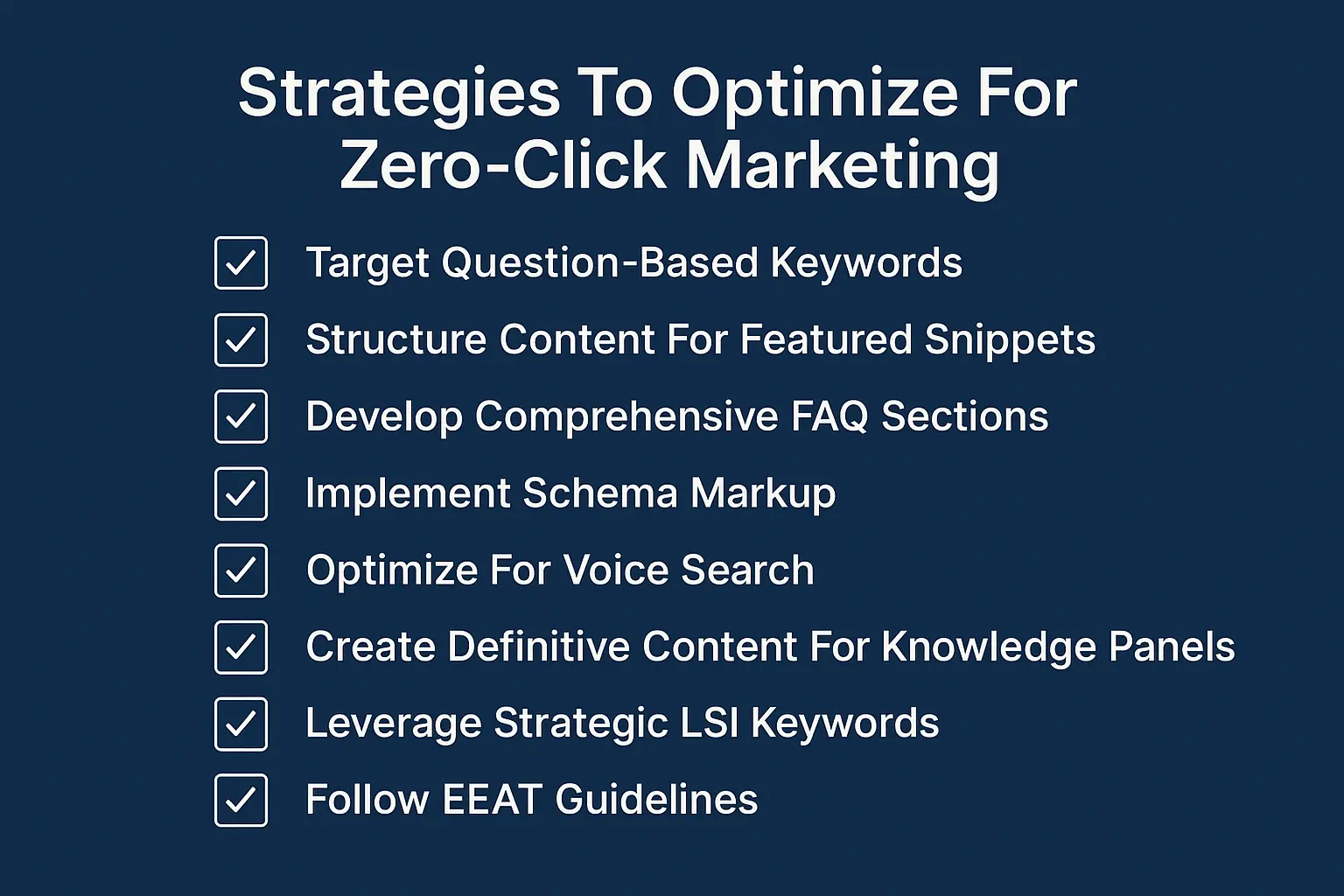
How to Measure Zero-Click Search
Track these metrics to evaluate your zero-click search performance:
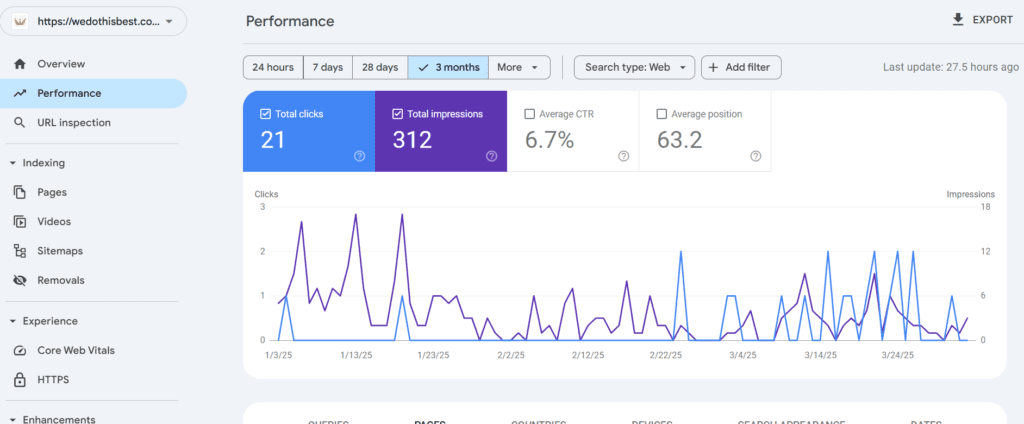
1. Search Console Insights
Google Search Console provides valuable data on:
- Impressions (how often your site appears in results)
- Position (where your site ranks)
- Click-through rates (comparing impressions to actual clicks)
Low clicks but high impressions often indicate zero-click performance.
2. Brand Search Volume
Monitor increases in branded searches after gaining zero-click visibility, as users often search directly for brands they discover through these results.
3. Keyword Ranking For Featured Snippets
Track which keywords trigger featured snippets for your content using tools like:
- SEMrush
- Ahrefs
- Moz
4. Local Search Analytics
For businesses with physical locations, monitor:
- Google Business Profile views
- Direction requests
- Phone calls from the profile
- Website visits from local listings
Balancing Zero-Click Optimization With Click-Through Strategy
While optimizing for zero-click searches, maintain these practices to encourage click-throughs:
1. Create Curiosity Gaps
Provide enough information to satisfy the initial query while suggesting valuable additional details available on your website.
2. Optimize Meta Descriptions
Craft compelling meta descriptions that promise additional value beyond the featured snippet information.
3. Develop Deep Content
Create comprehensive resources that go beyond surface-level answers, encouraging users seeking detailed information to click through.
4. Focus On Complex Topics
Target queries that cannot be fully answered in a snippet, requiring users to explore more comprehensive content on your site.
Are AI Overviews always correct?
AI Overview information is not always 100% correct. Multiple studies and expert analyses show that while AI-powered search engines like Google’s AI Overview can quickly synthesize and present information, they often struggle with accuracy, especially for complex or nuanced queries.
Recent research from Columbia University found that AI search engines provided incorrect answers to more than 60% of queries when asked to cite news articles, and they often did so with high confidence, rarely signaling uncertainty or refusing to answer.
While AI Overview tools can enhance user experience and efficiency, their information should not be assumed to be 100% accurate. Users should verify critical facts from trusted sources before relying on AI-generated answers.
The Future Of Zero-Click Searches
The zero-click trend is rapidly evolving. AI assistants are becoming part of search results, delivering instant answers tailored to individual users. There’s also a rise in visual and multimedia-based results, alongside a growing focus on local zero-click queries. Voice search continues to fuel demand for quick, direct responses. To stay visible, content strategies must adapt continuously to these changing search behaviors.
Conclusion
The shift toward zero-click searches represents not just a challenge but an opportunity for savvy content creators. By implementing these strategies, you can maintain visibility, build authority, and continue connecting with your audience even as search behavior evolves.Need help ranking in zero-click results? We specialize in optimizing content for featured snippets, voice search, and rich results so your brand shows up, even when users do not click. Just fill the form and we can get started!






1 Comment
Local SEO Optimization Tips for 2025 - Rank Your Business Organically
[…] How can I optimize for zero-click searches in my local SEO […]